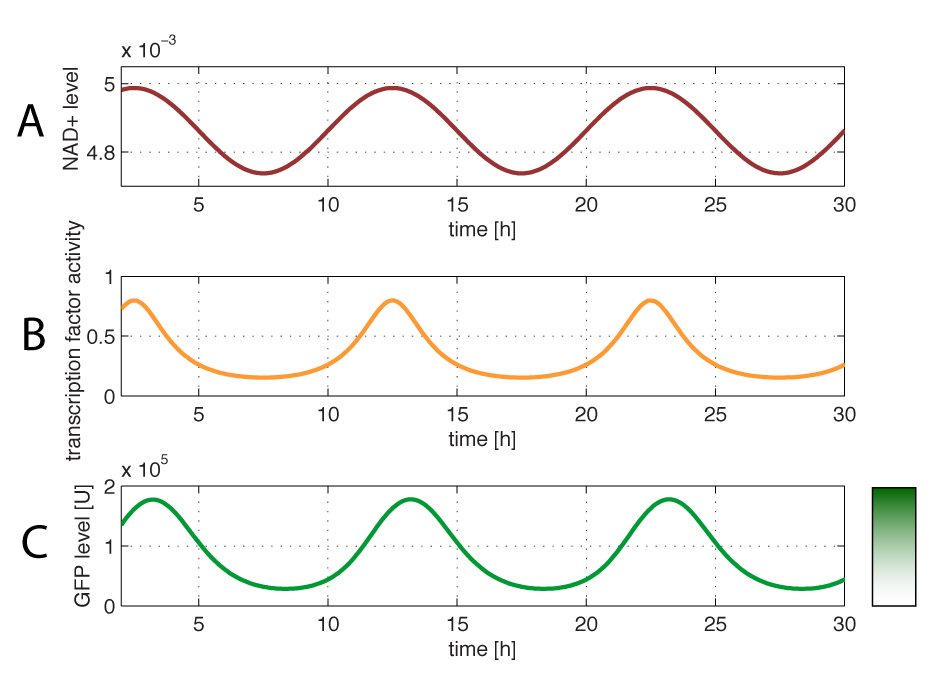Team:DTU Denmark/applications
From 2009.igem.org
| Line 264: | Line 264: | ||
| - | <p></p> | + | <p align="left"><i>“Synthetic Biology is an art of engineering new biological systems that don’t exist in nature.”</i><br></p> |
| + | |||
| + | <p align="right"><i>-Paras Chopra & Akhil Kamma</i><br><br></p> | ||
| + | |||
| + | <p>In nature, biological molecules work together in complex systems to serve purposes of the cell. In synthetic biology these molecules are used as individual functional units that are combined to form tailored systems exhibiting complex dynamical behaviour. From ‘design specifications’ generated from computational modelling, engineering-based approaches enables the construction of such new specified gene-regulatory networks. The ultimate goal of synthetic biology is to construct systems that gain new functions, and the perspectives of the technology are enormous. It has already been used in several medical projects and is predicted to play a major role in biotech-production and environmental aspects.</p> | ||
</font> | </font> | ||
Latest revision as of 03:24, 22 October 2009

| Home | The Team | The Project | Parts submitted | Modelling | Notebook |
|
- Applications and perspectives - Safety considerations
- Instructions - Output format
|
The project Applications and perspectives There are numerous potential applications for our genetic device, but here we have highlighted three key applications: an in vivo redox sensor, improved chemostat product formation and applications in cancer research. i) Reporter gene expression regulated by the Redoxilator – an in vivo redox sensorThe gene encoding green fluorescent protein (GFP) is widely used as a reporter gene in molecular biology. By placing the ROB promoter upstream of a GFP gene on a plasmid, and transforming the whole system into a yeast cell, GFP will be expressed at certain NAD+/NADH levels. When the REX-activator protein is bound to DNA, GFP expression will produce a visible and quantitatively measurable signal, which will be an indirect measure of the NAD+/NADH ratio.
A Redoxilator plasmid can be transformed into any yeast cell to analyse the NAD+/NADH level by online measurement of reporter gene expression. The internal redox level of the cell is very indicative and have serious impact on product formation of many products. The measuring of cellular NAD+/NADH levels is usually a difficult process, especially due to fast changes in NAD+/NADH ratio that can occur when a sample is taken and exposed to slightly new conditions. With this sensor system, the quantitative measurement of the reporter gene will provide a fast and reliable way to determine the NAD+/NADH ratio in vivo. The plasmid can be transformed into a yeast strain allowing the NAD+/NADH ratio to be continuously monitored. As an example this plasmid can be used to study whether an engineered yeast strain has an altered NAD+/NADH ratio. The plasmid can be transformed into different yeast strains (e.g. wild type versus an engineered strain or two production strains) and the NAD+/NADH ratio can be compared. ii) Product formation regulated by the Redoxilator – an attempt to improve and prolong chemostat processes When S. cerevisiae are grown continuously in a chemostat, the productivity of e.g. antibiotic or protein product gradually decreases [Personal correspondence with the fermentation industry]. This occurs during maximum production and is believed to be the result of metabolic adaption with reduced product formation as a consequence. The metabolic adaption is believed to occur because the cells are stressed by the extensive production. The cells will adapt to the new metabolic situation, which will gradually lead to lower production rates. This is highly undesirable in the biotech industry, as the chemostats will have to be restarted on a regular basis, which is costly and time consuming.
Changes in the NAD+/NADH ratio (A: top graph) lead to change in the Rex DNA binding affinity (B: middle graph) leading to controlled bursts of reporter gene expression (C: lower graph). A strategy to lower the effect of the metabolic adaption could be to couple the protein productivity with our redox-sensing device. If the NAD+/NADH level vary over time, it will lead to periodic burst of gene expression leading to product formation. Consequently the cells will have time to recover periodically from the metabolic stress that occurs during the protein production phase. There are many indications that this will lead to a prolonged effective chemostat operation, and ultimately higher accumulation of product before a costly restart of the chemostat is required.
iii) Yeast as a model organism for humans: Redoxilator in cancer research Yeast is used as a model organism for humans in many research projects. As an example, studies of the yeast cell cycle have paved the way for most of the knowledge about the cell cycle in mammalian cells. As yeast has been widely used as a model organism for studying cancer an integrated tool for detecting a significant change in the redox potential would ease this research, especially because a rising NADH level is seen as a hallmark of carcinogenesis. |
“Synthetic Biology is an art of engineering new biological systems that don’t exist in nature.” -Paras Chopra & Akhil Kamma In nature, biological molecules work together in complex systems to serve purposes of the cell. In synthetic biology these molecules are used as individual functional units that are combined to form tailored systems exhibiting complex dynamical behaviour. From ‘design specifications’ generated from computational modelling, engineering-based approaches enables the construction of such new specified gene-regulatory networks. The ultimate goal of synthetic biology is to construct systems that gain new functions, and the perspectives of the technology are enormous. It has already been used in several medical projects and is predicted to play a major role in biotech-production and environmental aspects. |
| Comments or questions to the team? Please Email us -- Comments of questions to webmaster? Please Email us |
 "
"


